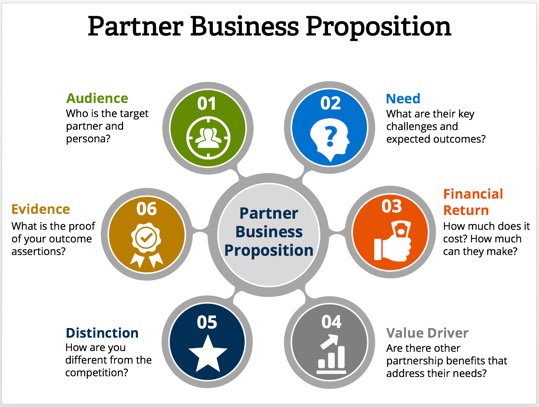How to Develop a Compelling Channel Partner Business Proposition
- With more suppliers competing for channel partner mindshare, a strong business proposition is critical
- The first step to crafting a partner business proposition is to identify the ideal partner profile you are looking to recruit
- Channel sales and marketing should test business propositions with current and potential partners
“Why should we partner with your company?”
If you and your team can’t provide a potential or existing channel partner with a good answer to this question, it’s time to work on your partner business proposition. With more and more suppliers competing for channel partner mindshare, this is arguably one of the most important components of a new partner recruitment toolkit. However, many suppliers either bury their value proposition in generic buzzwords (e.g. increased sales, quality support, ease of doing business with) or don’t figure it out at all! A partner business proposition should include the following components:
- Audience. The first step in crafting a partner business proposition is to identify the ideal partner profile you are looking to recruit into your partner program (e.g. business model, target markets, size), along with the personas within the partner organization involved in the vendor selection process (e.g. CEO, product expert, head of sales). Starting with the audience helps create business propositions that are more relevant and compelling to the audience and avoids the delivery of recruitment pitches that are merely product descriptions in disguise. For example, the C-level of a managed service provider is typically concerned with the additional revenue and profit a supplier’s offering drives (every $1 of the supplier’s offering drives $x in additional services) – whereas the primary concerns of a product manager at a distributor include the market demand for the offering, as well as the processes and policies that affect their profitability (e.g. returns, number of SKUs/product codes, stocking expectations, training requirements).
- Business need. Even a relatively inexperienced sales rep knows the importance of developing a clear understanding of a customer’s needs before attempting to sell them a product. The same is not always true when it comes to individuals tasked with recruiting new partners (e.g. partner development manager, partner account managers). Successful recruitment begins with obtaining a clear understanding of the target partner’s needs and motivations, then building a partner business proposition that demonstrates how you (the supplier) can meet them. Examples of frequently stated partner needs include attracting and retaining new customers, keeping pace with the competition, hiring the right talent, upgrading employee skills, increasing profitability and accelerating business growth.

- Financial return. A new partner recruiter must be able to demonstrate to a partner that they can make money selling their offering, and that they can accomplish it quickly. This means answering three fundamental questions: How much has to be invested to begin selling and supporting a supplier’s offering (e.g. training, staffing, equipment)? How long it will take for the investment to be paid back (i.e. how long does it take to break even)? How much can a partner earn? Considerations should include average deal size, margin, pull-through services revenues and cost savings driven by the partnership.
- Value driver. Beyond addressing the profit opportunity, the recruiter must explain how the partnership will deliver value to the prospective partner’s business and address their most urgent needs. Possible topics include brand strength; product quality and momentum; commitment to channels and channel partner success; channel entitlements (e.g. co-op, sales training, technical support); and operational excellence. For example, if the partner’s key business challenge is supporting new offerings or technologies, the value deliverables might include the extent of available training, supplier-provided services for resell (to supplement and not replace their own), support for hiring skilled employees and the tools provided to close more deals.
- Distinction. Think of financial return and value deliverables as basic requirements of a game. However, winning the game is contingent upon outlining a benefit you deliver that is important to the target partner and not readily available from your competitors (or other solution alternatives). For example, if a prospective partner is dissatisfied with their current supplier’s level of channel conflict, outline why channel conflict is not a prevalent challenge for your partner community (e.g. more than 80 percent of their revenues are derived from channel partners, direct compensation is channel-neutral), along with any other employed channel conflict avoidance tactics (e.g. selective recruitment strategy that avoids over-distribution, lucrative and fair deal registration program).
- Evidence. A strong partner business proposition supports its assertions with qualitative or quantitative proof points. It describes the results the product and partner program have produced (e.g. “XYZ generated an incremental $100 million in sales and ABC increased its margins by 10 points”) to validate the partner’s trust or perception that the supplier can deliver on its assertions. Examples of tools and deliverables that are used to communicate these proof points include partner testimonials, case studies, customer references and a partnership ROI calculator (preferably based on third-party validated data).
While this is certainly not an exhaustive list, hopefully it prompts a thought process as you build your own. It’s also critical for channel sales and channel marketing to work together to test the perceived business proposition with current and potential partners to validate the elements of your value, ability to deliver and relative position to the competition.
